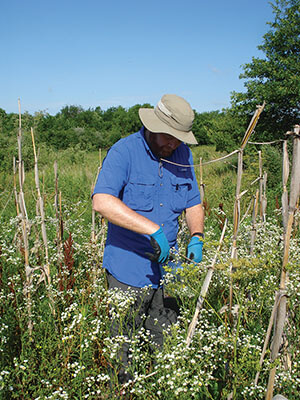
Pesticide residues are common in soils surrounding corn and soybean fields and are associated with fewer species of native bees.
Last month’s “Notes from the Lab” focused on how landscapes dominated by corn and soybeans can be both good and bad for honey bees. Good because colonies grow quickly when soybeans (at least some varieties) are in bloom and the bees take advantage of abundant nectar or pollen from soybeans and weedy clover flowers. Bad because colonies lose weight more quickly compared to when they’re surrounded by less corn and soybeans (and thus more wildflowers) for the remainder of the summer and fall. This means floral resources are a major limiting factor for honey bees in corn and soybean-dominated landscapes.
But what about other potential stresses on bees? The majority of corn and soybeans grown in the United States use pesticide seed treatments, most often comprised of neonicotinoid insecticides and fungicides. Do these pesticides ever contaminate things that honey bees or native bees interact with, such as wildflowers or soil? If so, are concentrations of the pesticides in soil or wildflowers sufficient to negatively impact bees? These are the topics for our twenty-eighth “Notes from the Lab,” where we highlight “Reduced species richness of native bees in field margins associated with neonicotinoid concentrations in non-target soils,” written by Anson Main and colleagues and published in the journal Agriculture, Ecosystems and Environment (2020).
For their study, Main and colleagues surveyed 24 agricultural fields located in four Missouri Department of Conservation Areas in north-central Missouri. The Conservation Areas are managed public lands that include areas of agricultural production to provide food resources and habitat cover for wildlife. At each Conservation Area, six study fields were sampled, three or four of which contained seed-treated corn or soybeans and two or three of which contained untreated fields. The treated fields were planted with either clothianidin-treated corn or imidacloprid-treated soybeans, and had also been planted with seed treatments at least one additional time within the past five years. The untreated fields had not been planted with neonicotinoid-treated seed for >10 years and remained in their current state of use (e.g., hayfield). Thus, this study did not assess differences between corn and soybean fields with and without seed treatments. Instead, the study assessed differences between seed-treated corn and soybean fields compared to untreated fields in their current state of use.
The authors took four types of data at each of the fields. First, soil was sampled and tested for pesticide residues at four times during the growing season: pre-seeding (mid-April), two weeks post-seeding (mid-June), mid-season (July), and during harvest (September). Soil samples were taken from within each field and outside of each field (i.e., in the margins where wildflowers and/or shrubs were growing). Second, plants in the field margins were collected in June, July and September and tested for pesticide residues. All soil and plant samples were assessed for concentrations of six neonicotinoids (acetamiprid, clothianidin, dinotefuran, imidacloprid, thiacloprid, and thiamethoxam) using high-performance liquid chromatography and tandem mass spectrometry (HPLC-MS/MS). Field margin plants were also tested for fungicides (azoxystrobin, fluxapyroxad, metalaxyl, pyraclostrobin, trifloxystrobin). These fungicides were often included on the treated seeds and/or were widely used in the study region.
In addition to the samples collected to assess pesticide residues, the authors also characterized the plant and bee communities at each site. The plant community in field margins was assessed using quadrats and all species were identified via the authors’ taxonomic knowledge. The bee community was assessed using a combination of blue vane traps and sweep netting at each site, then identifying each of the species using published keys.
So, what did they find? Did the fields and field margins next to seed-treated corn and soybean fields contain more pesticides than untreated fields? Yes. Neonicotinoids were detected in 53% (pre-seeding) to 93% (harvest) of field margin soils adjacent to seed-treated corn and soybean fields, while 22% (pre-seeding) to 56% (harvest) of field margin soils adjacent to untreated fields contained neonicotinoids. As can be seen in Fig. 1, there were also greater concentrations of neonicotinoids in the soils from fields and field margins that used seed treatments compared to untreated reference fields (compare the height of the bars on the left side of the dotted line to the bars on the right side of the dotted line). Conversely, neonicotinoids were rarely found in the wildflower plants located in the field margins of either seed-treated or untreated fields. Only 9% of wildflower samples next to treated corn and soybean fields contained neonicotinoids, while 7% of wildflowers next to untreated fields contained neonicotinoids. Fungicides were found in 40% and 15% of wildflower samples taken from the margins next to treated and untreated fields, respectively.
What about the concentrations of pesticides in soil and plants? Were they at levels that could harm bees? This is a trickier question. While concentrations of most pesticides were very low in the field margin plants and unlikely to lead to risk on their own, concentrations in soils were much higher. Honey bees don’t interact extensively …


